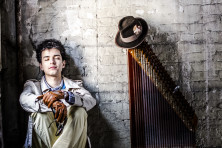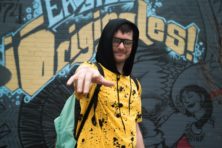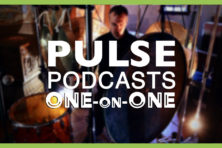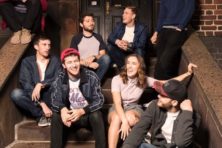Gong Meditation Tour Makes Stop In Sturgeon Bay
- Share
- Tweet
- Pin
- Share

Kenny Kolter will bring his Gong Meditation Tour to Benny D’z in Sturgeon Bay on May 18. Submitted photo.
Nine years ago, a friend invited drummer and percussion player Kenny Kolter to a “gong bath.” As someone who grew up appreciating the emotive experience of music, the offer piqued his interest and Kolter and his wife decided to attend.
Despite its name, a gong bath does not involve water. Rather, it is a form of sound therapy in which attendees are “bathed” in the sounds and vibrations of the gong. Kolter, who had a “regular corporate job” at the time, says the experience changed his life. As he recalls, he looked at his wife and said, “That’s what I want to do!”
It wasn’t long before Kolter purchased his own gong and began experimenting with the potential of playing the gong for meditation sessions. He made his first meditation CD and began a career as a sound therapist.
In the past eight years, Kolter has led more than a thousand group meditations and hundreds of individual sound therapy sessions, along with several Gong Meditation Tours. He has provided Sound Therapy sessions for treatment centers, correctional institutions and healthy aging programs, among others.
This weekend, he will embark on a three-day visit to Northeast Wisconsin (sponsored by The High Heart Project, of Green Bay), including a session in Sturgeon Bay.
I had the chance to reach out to Kolter recently with a questionnaire about his experience as a sound therapist and leader of his Gong Meditation Tour. Despite being in the middle of an incredibly busy tour (he did 25 events in 17 days, plus private sessions), he was gracious enough to share the ins and outs of his journey.
Kolter will bring his Gong Meditation Tour to Benny D’z in Sturgeon Bay on Monday, May 18 from 6:30 – 8 pm. Tickets for the session are $20 and attendees are encouraged to bring a yoga mat, blanket and pillow (if desired). Pre-registration is encouraged and can be done by contacting Chris Zimonick at [email protected] or calling 920.819.1341.
Alyssa Skiba (AS): Tell me about your background as a musician and sound therapist.
Kenny Kolter (KK): I’ve been playing drums and percussion on and off since age nine. The drum bug as a child bit me and it never left. I have come to realize as I get older that even as a child I was attracted to the emotive and expansive aspects of music – how music and sound can create depth of feeling, energy and capture mood.
AS: What instruments do you play?
KK: I play a variety of what I consider historically sacred instruments: gongs, drums, Tibetan singing bowls, rattles, chimes and Burmese temple bells. These instruments have been used by Shamans, medicine men and women, priests and tribal elders for thousands of years for ceremonies, healing, calling in their ancestors, and celebration. I feel that part of my mission in life is to bring awareness to the fact that a simple instrument like a drum or rattle can be a vehicle for transformation of consciousness.
AS: What is gong meditation?
KK: When someone asks me what I do for a living, I share that I play a variety of instruments as a backdrop for people to meditate and pray. A gong meditation is an opportunity to allow the sounds of the instruments I mentioned to be a vehicle for quieting the mind. It’s a bit counter-intuitive because most people think that a gong is a fairly one-dimensional instrument creating big bold splashy types of sounds. And gongs of course do just that. But when a gong is played with sensitivity, awareness and approached in a subtle manner, there is an entire world of sound that can be teased out of it. Attendees are continually amazed and aghast at the vast sonic palette that resides within the instrument.
AS: What are the benefits?
KK: The sounds and vibrations affect everyone differently. There is no one single desired outcome for the participants. I am fortunate that I have had folks who have attended 20 – 30 sessions and they all have shared that each session has its own unique flavor and energy. It’s one on the many reason I so enjoy this work. I share all the time that I feel like a kid with a new box of crayons every time I sit down to play.
AS: You approach it as both a performing artist and a healer. Can you explain how you merge both of these?
KK: These sacred instruments require a different type of approach than, let’s say, a traditional drum kit. While some of the technique, hand strength and muscle memory may be the same for the playing the gong, in a sound healing environment the key is to play intuitively. I often share that the gong, Tibetan bowls, etc. are instruments that one plays with and from the heart. As a performing artist and a healer I feel that my role is primarily to be in service. As a musician my focus is to serve the music. As a sound healer my role is to be in service to the group or the client. A term I like to use is ‘reading the tambour of the room.’ For me it’s tuning in, centering myself, and allowing God or Spirit to flow. I am blessed to be able to share my passion for music and sound as texture, color and feel in environments where folks are battling cancer, are incarcerated, in recovery or are looking for a sense of relaxation. These environments are so entirely different but the common thread is this – sound affects our physiology in amazing ways. Our bodies, by design, are amazing sonic conductors. We all learned in third grade science class that our bodies are made up of approximately 70 percent water. Sound travels five times faster in water than it does in air. While of course we are hearing with our ears, we are also absorbing it all on a cellular level.
AS: What is the experience like for the audience?
KK: The number one piece of feedback I receive nightly is that the attendees’ share that the hour-long experience seems to last 20 minutes. To me that’s what meditation is: when we lose track of time and self. We can achieve a state of peaceful, restful alertness.




